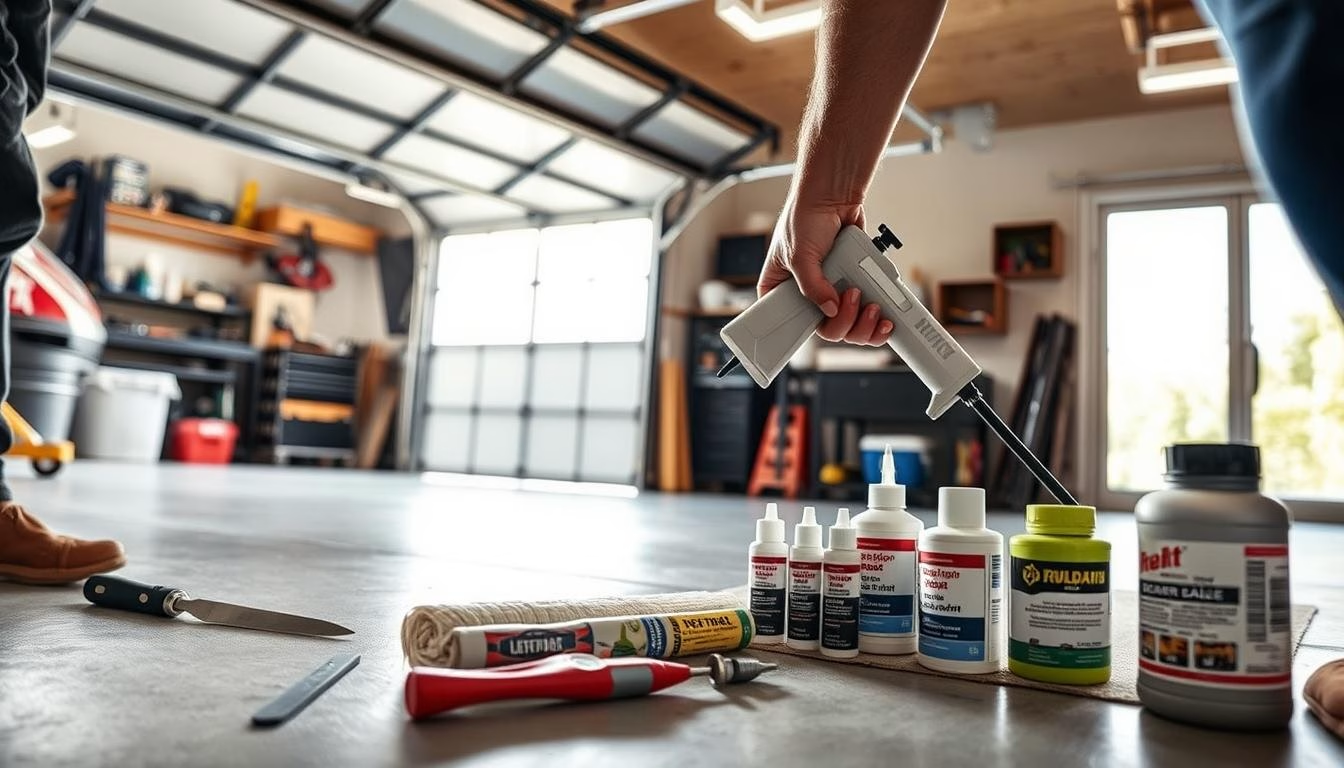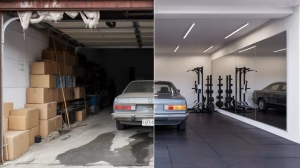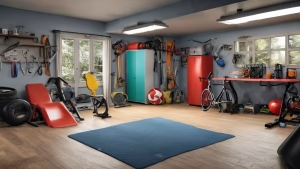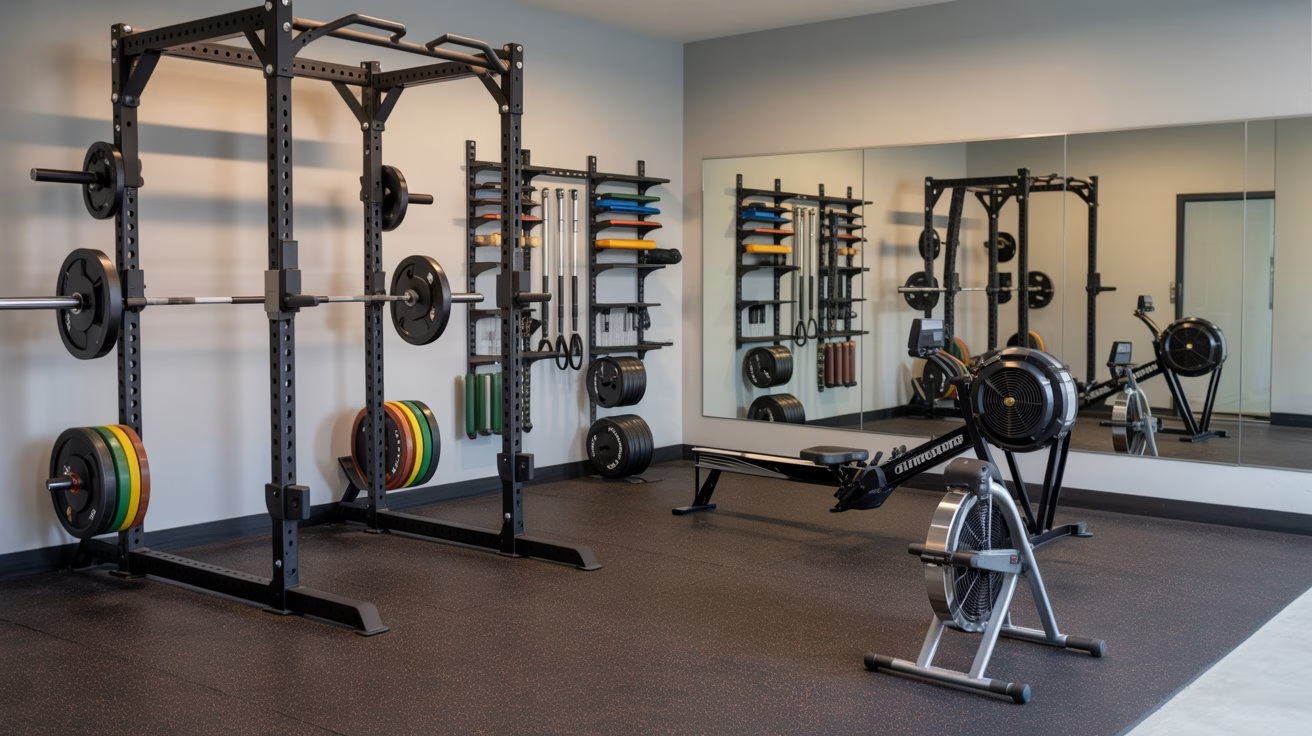Gaps between the garage door and floor can lead to drafts, pests, and moisture infiltration. It’s crucial to understand how to fill these gaps to maintain your garage’s integrity and comfort. An effective garage door gap filler or a sturdy garage door bottom seal can efficiently address these issues.
Whether caused by wear and tear or improper installation, addressing the gap promptly is vital. This guide will walk you through identifying the gap type, choosing the right sealant, and implementing DIY and professional solutions.
Key Takeaways
- Gaps between the garage door and floor can cause drafts and allow pests into your garage.
- Understanding how to fill the gap between garage door and floor is essential for protecting your space.
- Utilizing a garage door gap filler or garage door bottom seal can help mitigate these issues.
- Both DIY and professional methods are available to address the gap effectively.
- Regular maintenance and inspections can prevent future gaps from forming.
Understanding the Importance of a Garage Door Seal
Keeping your garage door sealed is vital for a comfortable and secure environment. A well-sealed garage door saves energy, safeguards your belongings, and keeps pests out. It’s a key factor in maintaining your garage’s integrity.
Why Sealing Matters
Sealing your garage door gap is essential for several reasons. It improves insulation, keeping warmth in winter and cool air in summer. This not only reduces energy use but also lowers your utility bills. Moreover, a tight seal blocks debris, insects, and rodents, protecting your items.
Common Problems Caused by Gaps
Gaps in your garage door can cause several issues. Moisture can seep in, leading to mildew and rust damage. Drafts can also affect room temperatures. Furthermore, poor seals increase wear and tear, requiring more frequent repairs and maintenance.
- Enhanced insulation reduces energy costs.
- Prevents pest and debris infiltration.
- Protects against moisture-related damage.
- Improves the durability of the garage door.
It’s crucial to address these gaps quickly. This ensures your garage door remains sealed, maintaining its efficiency and integrity.
Identifying the Type of Gap
Before you start looking for solutions, it’s vital to know the type of gap you’re facing. Whether it’s a weatherproof garage door gap or something else, pinpointing it accurately is key.
Measuring the Gap
Begin by measuring the gap’s width and length at various points on the garage door. This ensures you grasp the full extent of the issue. Use a measuring tape and record the measurements. These will help you pick the right weatherproof garage door gap seals or other solutions.
Evaluating Garage Door Condition
Next, assess your garage door’s condition. Check for signs of wear and tear, like rust, dents, or visible damage. This can tell you if a simple seal replacement is enough or if more repairs are required. Knowing the door’s condition is crucial for choosing the best garage door gap solutions.
Choosing the Right Sealant
Sealing your garage properly is key to keeping it secure and energy-efficient. The right sealant can block gaps, preventing moisture, pests, and energy loss. It’s important to know the different types of garage door seals and choose the best one for your needs.
Types of Sealants Available
There are several sealant options for your garage door:
- Rubber Seals: These are common for their durability and flexibility, providing a tight fit against diverse surfaces.
- Vinyl Seals: Known for their resistance to extreme weather conditions, they are less flexible but highly durable.
- Brush Seals: Ideal for uneven floors, these sealants use bristles that adapt to surface irregularities.
- Foam Sealants: These offer excellent insulation properties and are perfect for significant gaps.
Which Sealant Works Best for Your Garage?
Choosing the right sealant depends on several factors. Consider the gap size, floor type, and personal preferences. A garage door threshold seal is often the best choice due to its versatility. It works well on various surfaces and gap sizes.
It’s also crucial to understand how to apply different seal types correctly. This ensures they last long and work effectively.
DIY Methods to Fill the Gap
Fixing the gap between your garage door and floor is achievable with basic DIY methods. These approaches not only improve insulation but also save you money. Here are two effective DIY solutions:
Using Weatherstripping
Weatherstripping is a simple and effective DIY solution. It involves attaching a strip along the garage door’s bottom edge.
- Measure the garage door’s width to figure out the weatherstripping length.
- Clean the door’s bottom edge for better adhesion.
- Remove the backing from the weatherstripping and press it firmly onto the edge.
- Close the door to check if the strip seals the gap between the door and floor.
Crafting a DIY Threshold
Creating a DIY threshold is another effective way to seal your garage door. This method involves installing a raised barrier on the floor where the door closes.
- Buy a rubber or vinyl threshold kit from a local hardware store.
- Measure and cut the threshold to fit your garage door’s width.
- Clean the floor where the threshold will be placed.
- Apply the adhesive from the kit or a recommended material.
- Position the threshold on the adhesive and press firmly.
- Wait for the adhesive to set as instructed before using the garage door.
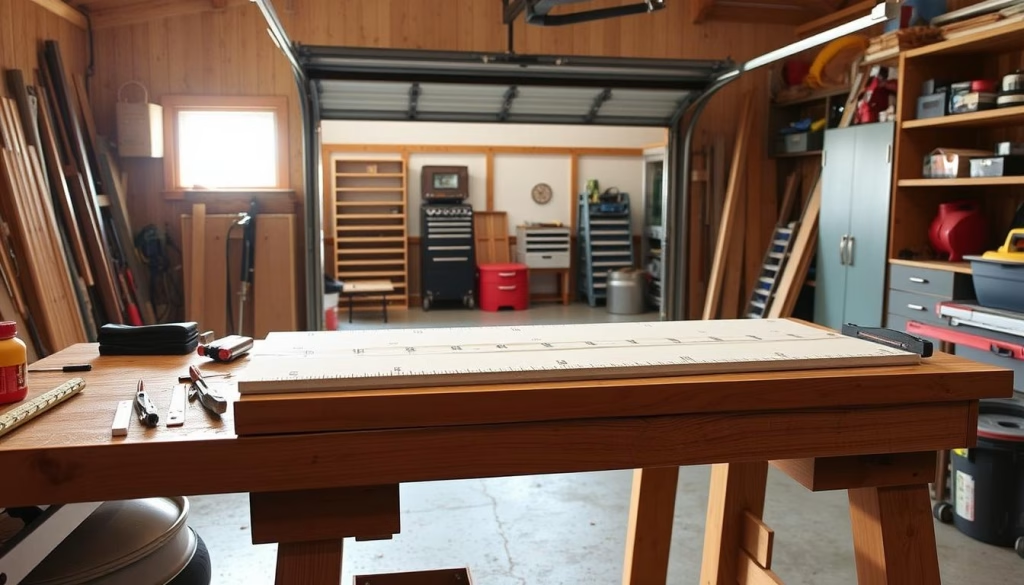
By employing these DIY techniques, you can efficiently seal the gap between your garage door and floor. This ensures a more insulated and secure garage space.
| Method | Materials Needed | Steps Involved |
|---|---|---|
| Weatherstripping | Weatherstripping material, measuring tape, cleaner | 4 steps to attach the strip |
| DIY Threshold | Threshold kit, adhesive, measuring tape, cleaner | 6 steps to install the threshold |
When to Call a Professional
Some garage door repairs can be handled by yourself, but others require professional help. Knowing when to call a professional is key to keeping your garage door safe and working right.
Signs You Need Expert Help
Clear signs indicate when you should get an expert’s help. If your garage door malfunctions often, makes strange noises, or has visible gaps, it’s time to act. Trouble opening or closing the door smoothly could mean alignment problems that need a pro.
Finding the Right Garage Door Installer
Choosing the right garage door installer is crucial for quality repairs. Start by looking up trusted installers in your area. Check their reviews and make sure they’re certified. A skilled installer will give you a detailed plan and solutions that fit your needs. They’ll also offer warranties and maintenance advice to keep your door in top shape.
Preparing for the Repair Process
Before starting to fix the gap between your garage door and the floor, it’s crucial to prepare well. Having the right tools and knowing how to maintain your garage door safely ensures success and safety. This preparation is key to a smooth repair process.
Tools You'll Need
Having the right tools makes the repair job much easier. Here’s a list of essential tools:
- Measuring tape
- Adjustable wrench
- Screwdrivers (both flathead and Phillips)
- Utility knife
- C-clamps
- Hammer
- Level
- Replacement sealant or weatherstripping
Having these tools ready ensures you’re well-prepared. It also promotes safe garage door maintenance during the process.
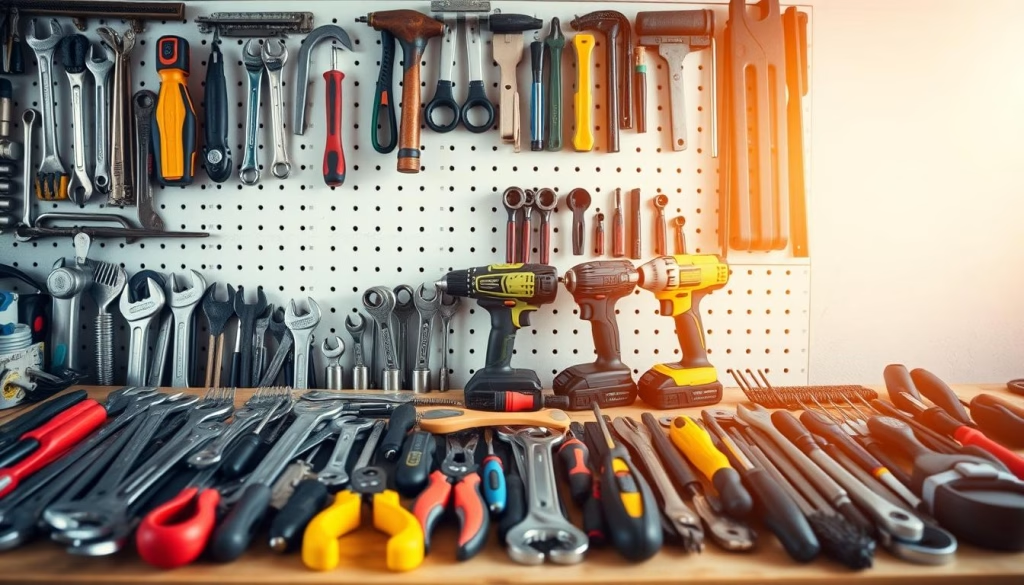
Safety Precautions to Consider
Safety is paramount when doing any home repair, especially garage door maintenance. Follow these safety precautions for a secure repair process:
- Disconnect the garage door opener to prevent any accidental movements.
- Wear safety gloves and glasses to protect your hands and eyes from debris and sharp edges.
- Use C-clamps to secure the garage door in place and prevent it from slipping.
- Ensure the area is well-lit to avoid any mishandlings of tools and materials.
- Follow manufacturer instructions on any sealants or tools used.
By following these safety measures, you can greatly reduce risks. This enhances the effectiveness of your repair tasks.
Maintenance Tips for Garage Door Seals
Maintaining garage door seals is crucial to keep your garage safe from the elements and pests. Proper care extends the seal’s life and maintains a controlled, efficient garage environment.
Regular Inspections
Inspecting your garage door seals regularly is key to their proper functioning. Look for wear signs like cracks, gaps, or detachment. These tips help spot issues early, preventing major problems.
- Inspect seals twice a year for damage or wear.
- Test seal integrity by closing the door and checking for light leaks.
- Watch for moisture or pest signs, indicating a compromised seal.
Maintaining a Sealed Environment
After checking seals, maintaining a sealed environment is ongoing. Clean seals regularly to prevent wear from dirt and debris. Use mild detergent and warm water for cleaning, then rinse well.
| Maintenance Task | Frequency | Details |
|---|---|---|
| Visual Inspection | Twice a year | Check for cracks, gaps, and attachment issues |
| Seal Cleaning | Monthly | Use a mild detergent and water |
| Seal Lubrication | Quarterly | Apply silicone-based lubricant |
| Professional Inspection | Annually | Have an expert check for comprehensive maintenance needs |
By adhering to these maintenance tips, you can extend your garage door seals’ life. This ensures a secure, comfortable garage environment.
Additional Solutions for Garage Comfort
Improving your garage’s comfort can greatly enhance its functionality and appeal. By implementing various strategies, you can make your garage more inviting and efficient. This transformation will significantly benefit your home.
Insulation Options
Choosing the right insulation for your garage door is key to maintaining a comfortable temperature all year. Insulated garage doors help reduce energy loss, making your garage more energy-efficient. To further optimize temperature control, consider insulating the walls and ceiling.
Popular insulation materials include fiberglass batt, foam board, and reflective insulation. These options can help you achieve better temperature regulation in your garage.
Alternative Flooring Solutions
Upgrading your garage flooring can dramatically change its look and usability. There are many garage floor solutions to suit different needs and preferences. Epoxy coatings, for instance, offer a durable and attractive finish, making them a favorite choice.
Interlocking tiles and specialized floor mats are also great options. They are easy to install and highly durable. Alternatively, a concrete stain can enhance your garage’s aesthetics while being cost-effective.
Conclusion: Securing Your Garage Space
Filling the gap between your garage door and the floor is crucial for maintaining a well-protected and functional garage. Understanding the importance of a garage door seal is key. Identifying the type of gap and choosing the right sealant ensures your garage remains secure and energy-efficient.
The Benefits of a Well-Sealed Garage
A well-sealed garage protects against water intrusion, pest infestations, and temperature extremes. This contributes to the overall comfort and longevity of your space. Sealing garage door gaps reduces energy costs and safeguards stored items from environmental damage. It also keeps your garage cleaner by preventing dust and debris from entering.
Encouraging Preventative Measures
Regular inspections and preventative garage maintenance are essential. Simple actions, like periodic checks and addressing minor gaps promptly, can prevent bigger issues. Investing in quality sealants and consulting professionals when necessary enhances your garage’s durability and security.

